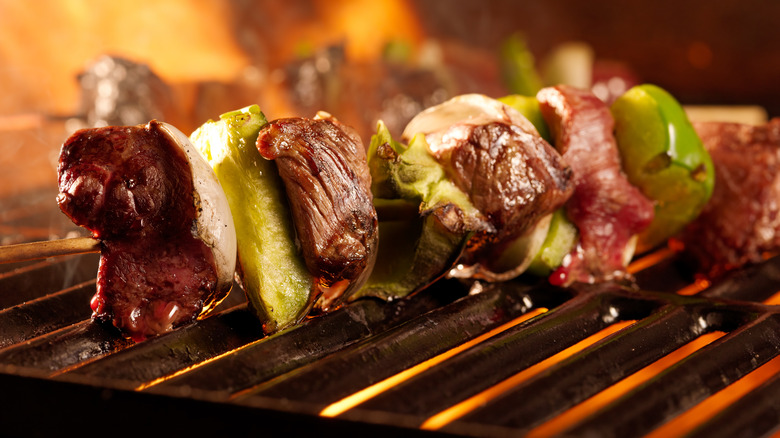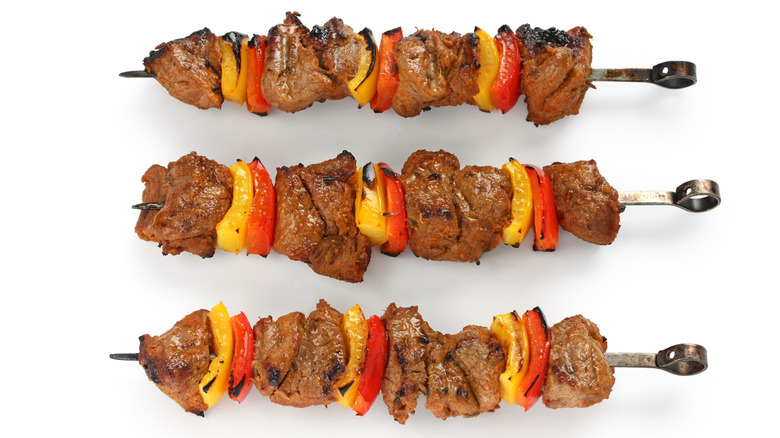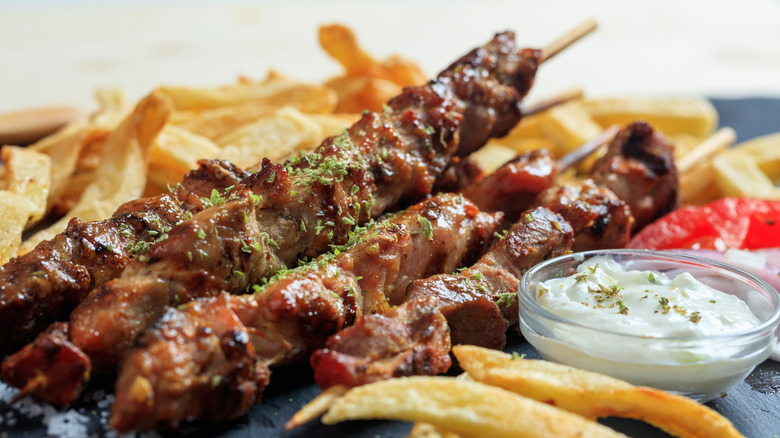Kebabs Vs. Souvlaki: What's The Difference?
A kebab by any other name might just be souvlaki. Both involve chunks of marinated meat cooked on a skewer. Both have been around for millennia. Both have endured through the ages and remain barbecue favorites. But while kebabs originated in the region now known as Turkey, souvlaki is a Greek dish.
Another major difference: According to Delighted Cooking, traditional Turkish kebabs almost never feature pork, a nod to the dietary preferences of the country's Muslim population. On the other hand, pork is the preferred ingredient in Greek souvlaki. Other differences, per Difference Between, include garlic (it's integral to souvlaki, but optional in kebabs) and serving style (souvlaki comes rolled in a pita, while kebabs are served on a plate).
One more key difference, according to Cosmos Philly: the marinade. Souvlaki is marinated in an acid-forward blend of vinegar, lemon juice and red wine. Other common ingredients include Greek oregano, olive oil, garlic salt, and pepper. Traditional kebab marinade consists of olive oil and assorted spices often including turmeric, cumin, coriander, and paprika.
What is a kebab?
Kebabs are skewered chunks of meat, usually grilled over an open flame. Also known as "shish kebab," the dish is a classic barbecue favorite. In the U.S., the terms kebab and shish kebab are often used interchangeably. According to The Spruce Eats, the name derives from the Turkish words şiş (skewer) and kebap (roast meat), so shish kebab equals skewered roast meat. The method of cooking developed out of necessity among the nomadic tribes who once roamed the region. History also traces a variation of the dish to soldiers on the field during Byzantine-era battles for Anatolia who used their swords to grill meat over open fires.
Lamb is the most common meat used in traditional Turkish kebabs, but Istanbul on Food lists beef, chicken, and fish among other popular choices. The meat is usually marinated in a blend of olive oil, lemon juice, and onions prior to grilling. Variations on the traditional marinade may include herbs and seasonings like marjoram, bay leaves, cinnamon, and allspice (via The Spruce Eats). Adventurous cooks may incorporate regional or international flavors like Guy Fieri's Jerked Chicken Kebabs or Robin Miller's Grilled Asian Beef Kebabs.
What is souvlaki?
Sometimes called "Greek kebabs," souvlaki is almost always made with pork (chicken is the runner-up choice with fish and vegetarian options gaining popularity). The meat is marinated in an acid-forward blend of lemon juice, olive oil, garlic, oregano, salt, and pepper, then grilled on a skewer.
Historians trace the origins of souvlaki to ancient Greece with notable references in the writings of Greek scholars Aristotle, Aristophanes, and Homer. Additional evidence of souvlaki's long and storied history showed up in the mid-20th century when archeological digs at the ruins of Akrotiri on the island of Santorini revealed souvlaki-suited grilling tools and artifacts dating as far back as 1645 B.C. (via Fork+Plate). Like Turkish shish kebab with the Turkish word shish meaning skewer, Cosmos Philly says the name souvlaki comes from the Greek word souvia, also meaning skewer.
The outlet also identifies another key difference between kebabs and souvlaki: The latter is rarely grilled with vegetables, although veggies on the side are common. Traditional souvlaki, according to Will Fly For Food, consists of skewered grilled meat served on a plate with vegetables, fried potatoes, pita bread, tzatziki, and a lemon wedge. For a to-go friendly option, order a souvlaki pita — all of the traditional ingredients, including the fried potatoes, come wrapped in pita bread.
How to eat kebabs and souvlaki
Kebabs and souvlaki are quintessential street foods. Easy to grab and go, the skewers make both dishes a hit for eating on the run. Etiquette Scholar says it's perfectly acceptable to munch grab-and-go kebabs directly off the skewer, but advises using the tines of your fork to pull meat and vegetables onto your plate for sit-down dining. Food & Wine offers tips for upping the ante. You could plate the kebabs on a bed or rice with a side of grilled vegetables or stuff the grilled meat into a pita. For an unexpected kick, try That Spicy Chick's recipe for creamy, tangy garlic sauce.
Greece Is digs deep in the do's and don'ts of ordering and eating souvlaki, with tips like do sit down and order for eat-in, but always step up to the counter for take-away; for a souvlaki pita, do start at the widest end and peel back the wrapper as you go. Salt & Lavender suggests creating a souvlaki-focused mezze platter with grape tomatoes, red onions, cucumber, feta cheese, Kalamata olives, lemon wedges, chopped mint, and parsley accompanied by olive oil and pita bread or naan.



